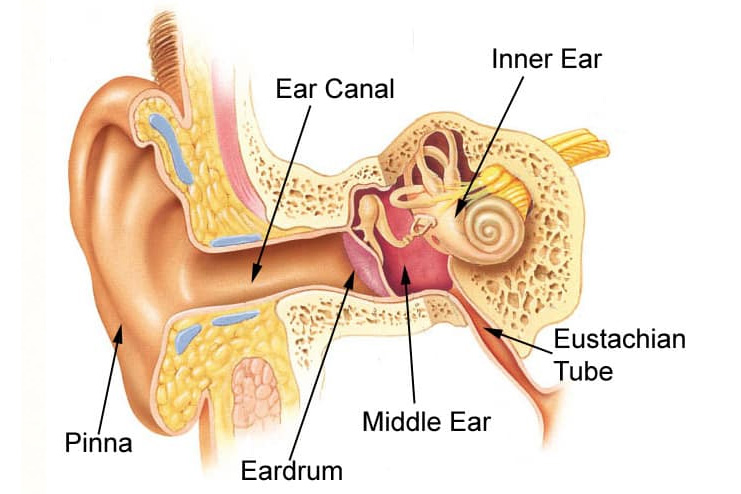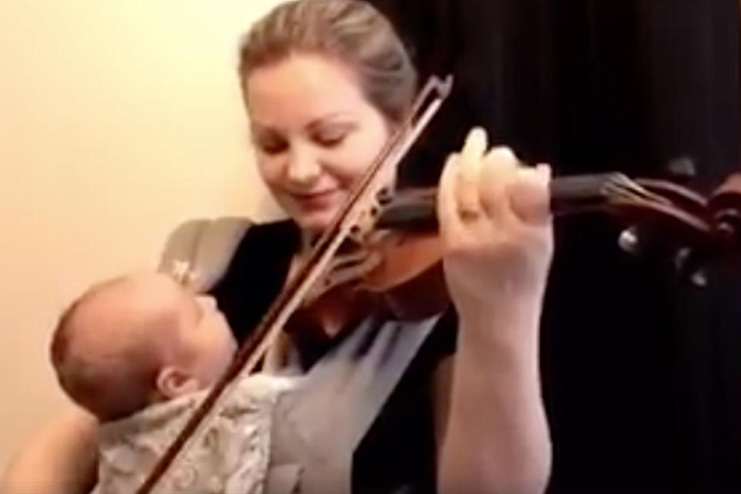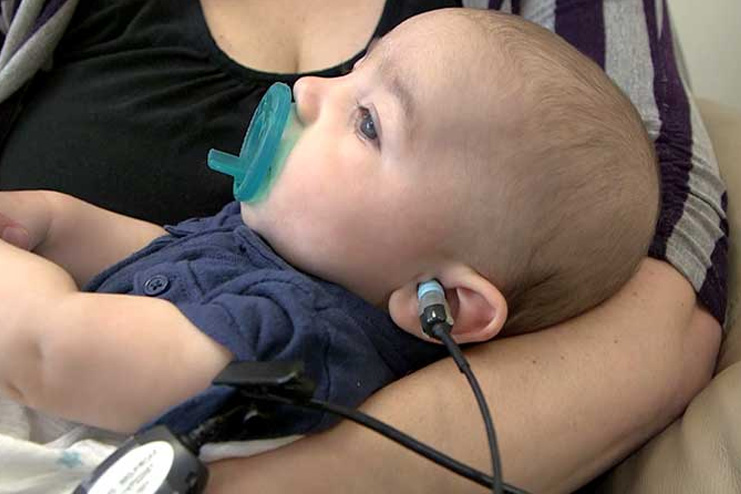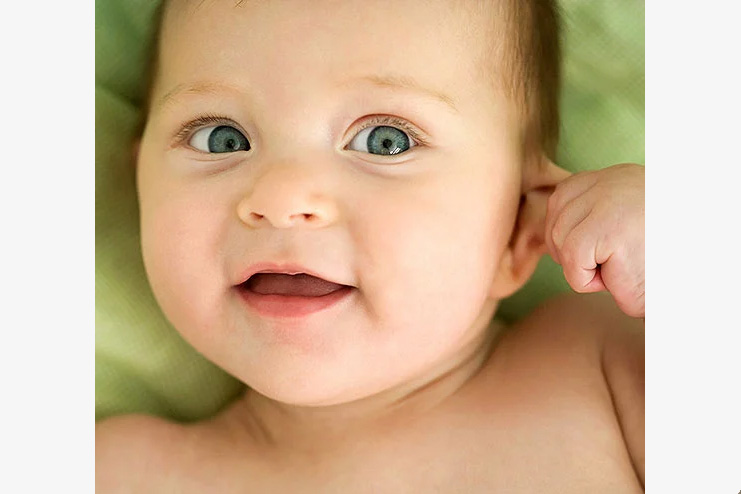Your newborn has been hearing the sounds since they are in the womb. When they are in the womb the sounds like mother’s heartbeat, gurgles of her digestive system, voice of the mother, and other sounds of the family members are all the baby’s world.
Singing lullabies and some nursery rhymes is what the parents love to do for their babies. Research from the University of Montreal showed that babies remain calm twice as long as they are listening to the song by their parents. Hearing is the more important milestone that you should check in your newborn in the early stages. Hearing is a useful tool that helps the baby to get the information from the world around her.
This article discusses some hearing problems in babies and it presents some techniques to test hearing problems in your baby.
How The Ear Works?

In order to understand the hearing loss in babies, it is more important to know how the ear works.
There are three layers in the ear namely outer ear, middle ear, and inner ear. The outer ear contains the visible part of the ear called pinna, and ear canal. The middle ear contains eardrum and the three tiny bones behind it which together vibrate and conduct sound into the inner drum. The inner ear contains cochlea, which are fluid are fluid filled chambers and tiny hair cells and nerve endings. These nerve fibres and hair cells stimulate when they receive the sounds and produce the electrical impulses to send to the brain.
The severity of the hearing problem may depend on the type of the layer in which the infection occurs.
• When the problem occurs in the outer or middle ear the hearing problem is usually temporary.
• The damage of the inner ear may result in permanent hearing loss.
Types of Hearing Loss:
Hearing loss can be classified into
• Mild
• Moderate
• severe, or profound
Babies born with mild or moderate hearing loss can listen most of the sounds through hearing aids. Careful selection and parental monitoring is required for the hearing aids to get the optimum benefits.
A child with severe to profound hearing loss could be able to hear only the louder sounds. They can not hear the speech at the conversational level.
Terms you should know when your baby has hearing problem:
Here are the few terms that you should be aware of when your baby has a hearing problem:
Audiogram: A chart showing the hearing abilities of your baby
Audiologist: A person who measures your baby’s hearing
Earache: The pain that prevails deep inside the ear
Otitis media: It regards the group of inflammatory diseases of the middle ear.
Otolaryngologist: a doctor who deals with the diseases and problems of the ear, nose, and throat.
Otologist: A doctor who deals with the diseases of the ear.
Speech – Language Pathologist: A health professional who is well trained to diagnose and treat the people with speech or language disorders.
Hearing Abilities Of NewBorn Baby:
Newborn babies can hear the noises fairly but not perfectly. The entire hearing apparatus remain immature in the newborn babies that restricts their hearing. Newborn babies can respond well towards the high pitched, and exaggerated sounds. The middle ear of the newborns is full of the fluid which may reduce their ability to hear. This fluid restricts the baby’s hearing abilities.
When Do Babies Start Hearing After Birth?
Babies can hear the voices when they are tucked up in the womb. Even if your baby is born with fully developed ears, it will take 6 months for them to hear the sounds clearly and understand their range. You may notice the fair development of hearing in babies at the age of 6 months. Babies will love to hear the voices from the moment they are born.
There are two reasons that may restrict the clear hearing in your baby. The first is your baby’s middle ear is filled up with some fluid which may take some time to clear. The second is, your baby’s brain parts that are associated with the hearing are still immature.
Newborn Baby Hearing Development:
Hearing is a very important tool for babies to develop their language, literacy, and brain.
Hearing is an important milestone for the newborn baby. By the age of 12 months, babies understand most of what they see and listen and start saying a few words. This time is regarded as the window of opportunity for language learning.
It is most important for the babies to be tested for the hearing before 1 month. Full hearing test should be done for the babies before the age of 3 months. Doctors start the treatment by the age of 6 months if they notice any kind of hearing problems. Any family history of hearing problems may put your baby at the risk of hearing problems. Even if the baby has passed the initial screening test, it is more important to look for the general symptoms of the hearing loss:
• You may not recognize the startle reflexes in the baby on hearing louder noises.
• Babies may not respond to the voices of the parents.
Babies may start to turn their eyes in response to the sounds by the age of 6 months. Here are the few other milestones that babies show in response to hearing:
• Reacts to loud sounds
• Makes soft sounds
• Smiles or calms down when you spoke to them
• Able to recognize your voice
How to Test Babies’ Hearing at Home?

Babies use their ears, eyes and other senses to learn the world around them. The most amazing thing with the babies is their ability to learn their family language by listening. You Can easily test for any hearing defects in your baby at home using the simple techniques:
Test 1: Play some music for your baby
Babies love to listen some music, and rhymes just like the adults. Babies will get many benefits from the musical environment. A gentle music can help for your baby’s cognitive and sensory development.
Play some music while your baby is crying, you may notice that they may stop crying and start to turn their head towards the noise source. This test works effectively from the age of 3 months.
Note: While playing music, make sure that it should not go beyond the permissible level. Normal noise level is about 60 decibels and the noises beyond 85 decibels may lead to hearing loses in babies known as noise induced hearing loss.
Test 2: Clap near your baby’s ear
Clap near your baby’s ear or do some noise by clicking two fingers. Babies may jump or startle when they hear some louder noises closer to their ear.
You may notice this startle reflex in the babies from their second week. Don’t worry if your baby do not show any startle reflex by this age as the developmental milestones may vary for each baby. Don’t do frequent noises as they may irritate your baby.
Test 3: Use some Test Materials
Here are a few test materials that are available at your home to test the hearing in your baby:
• Aluminium drink can
• Glass Jar
• Elbow Macaroni
• Steel spoons
You can make some baby friendly high frequency sounds with these materials that help to check the hearing in your baby.
Put some Elbow macaroni in the Aluminium can or glass jar and shake them near your baby’s ear. Your baby turns head towards the source. You can also strike the steel spoon on to the glass jar to make some high frequency.
Test 4: Observe their reaction on listening sounds
Newborn babies may not jump or startle on listening the high frequency sounds. Here is something you can check for hearing in your newborn baby.
Make some noise while your baby is sucking on for feeding or some pacifier. You may notice the change in their pace of sucking when they hear some sound. They may either slowdown or stop sucking on hearing sounds.
Test 5: make them to listen to audio
Hold your hand over the mouth and make sure that you do not wrap your voice. Hold your hand at a certain distance that your child does not read your lips. Make your child to rely only on audition alone and no visual cues. You can also hold a piece of paper over your mouth covering the movements of the lips.
Make your child to stand from half meter to meter away and ask them to repeat the sounds that you make. Here are a few short sounds that you can make to your child:
• Ah
• Oo
• Sh
• Ss
• Mm
• Ee
• Or
Now make your child to stand 3 meters away from you and repeat the same sounds in different order and ask them to repeat the same. Ensure to cover your mouth and allow your child to rely on audition.
Clinical Hearing tests for your baby:

Usually babies receive hearing screening before they leave the hospital and some may receive three weeks after discharge from the hospital of which very small percentage of babies are referred for further hearing testing.
Newborn hearing tests are used to examine the hearing in babies which are safe and comfortable. Early detection and management of the child’s hearing loss play an important role in the speech and language skills of your baby and they help your baby to achieve academic success.
The hearing tests are painless and are usually performed when the baby sleeps or rests quietly. Results of each hearing test are plotted on an audiogram. Here are a few tests to measure the hearing in your baby:
1) Otoacoustic Emission Test (OAEs):
In this process, a miniature earphones and microphones are placed in the ear and the responses are measured in response to the sounds that are played.
If the baby hears normally, the echos are reflected back into the ear canal and they are measured by the microphone.
2) Auditory Brainstem Response Test (ABR)(0-6 months):
This test tells how the inner ear and the brain pathways are working. This test is for the babies below the age of 6 months.
For this test, small band aid type electrodes are placed behind each ear and on the forehead of the baby. Sounds are produced to the ears using the miniature earphones. The electrodes pick up the responses from the hearing nerve and they are displayed on the screen.
3) Visual Reinforcement Audiometry (VRA) (above 6 months):
This test is performed for the babies above the age of 6 months.
During this test, a sound is played using either miniatures earphones or loudspeakers. In this process, child is trained to turn to the sound as per the movements of the animated toy.
Detailed information of the child’s hearing loss can be obtained in both the ears across the frequencies.
4) Conditioned Play Audiometry (CPA)(pre school age children):
This is a play like activity where the child is asked to drop a block or ball in the bucket every time the sound is heard. Children above the 4 years of age can play the computer game.
Risk Factors for hearing loss in babies:
Here are a few things that may put your baby at the risk of hearing problem:
• If your baby is born before the term.
• If your baby has stayed in the neonatal intensive care unit (NICU).
• Any complications during the birth.
• Frequent complaints of hearing infections.
• If your baby has infections that damage the hearing.
• Any abnormalities in the outer ear.
• Maternal diseases in the pregnancy
• Consumption of some drugs during the pregnancy.
• Genetic disorders
• Any family history of deafness.
• Any bacterial or viral illnesses that are passed to the baby during the process of delivery.
• Noise induced hearing loss
Baby hearing problem is greatly affected by the above factors.
Talk to your Doctor:
If your baby has hearing problem, your doctor might ask you the follow questions that you should prepare for in advance:
Any family history of hearing problem?
Was the child born before the term?
Did the child’s mother has any kind of medical problems during the pregnancy or at the time of delivery?
Did your child have any physical problems at the birth?
Did your child have any ear infections in the past?
How often does your child experience cold, allergic symptoms, and ear infections?
Tips To Protect Your Baby From The Hearing Loss:

Here are a few tips to protect your baby from the hearing loss:
• Protect your child from the louder noises.
• Be aware of the noise levels in your surroundings.
• Know the levels of the noises which are safe and which are dangerous.
• Get your child’s hearing tested at the early stages.
• Make sure to put some ear plugs when your baby is about to go around the louder noises.
• Don’t insert the Q-Tips deep into baby’s ear.
• If your child already has a hearing problem, talk to your doctor about the medicines that are to be avoided that may further worse the hearing problem.
In conclusion, listening plays a prominent role in the development of newborn baby. It helps babies to understand the world around them and respond accordingly. Child’s reading and writing skills are greatly influenced by their listening skills. Child with proper hearing can lead their life without any limitation.







































